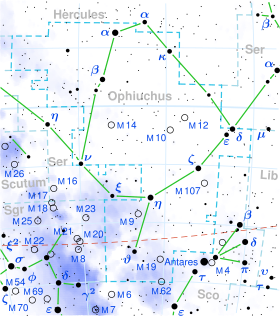74 Ophiuchi

| Observation data Epoch J2000 Equinox J2000 | |
|---|---|
| Constellation | Ophiuchus |
| Right ascension | 18h 20m 52.06435s[1] |
| Declination | 03° 22′ 37.7817″[1] |
| Apparent magnitude (V) | 4.85[2] |
| Characteristics | |
| Spectral type | G8III[3] |
| U−B color index | +0.61[4] |
| B−V color index | +0.91[4] |
| Astrometry | |
| Radial velocity (Rv) | +4.35[5] km/s |
| Proper motion (μ) | RA: −7.646[1] mas/yr Dec.: +12.546[1] mas/yr |
| Parallax (π) | 13.7320 ± 0.2060 mas[1] |
| Distance | 238 ± 4 ly (73 ± 1 pc) |
| Absolute magnitude (MV) | 0.34[2] |
| Details | |
| Mass | 2.38[6] M☉ |
| Radius | 10.52+0.32 −1.04[1] R☉ |
| Luminosity | 66.0±1.2[1] L☉ |
| Surface gravity (log g) | 2.70[6] cgs |
| Temperature | 5,073+271 −76[1] K |
| Metallicity [Fe/H] | -0.21[6] dex |
| Rotational velocity (v sin i) | 0.0[5] km/s |
| Age | 1.73[7] Gyr |
| Other designations | |
| Database references | |
| SIMBAD | data |
74 Ophiuchi is a suspected binary star[9] in the equatorial constellation of Ophiuchus, near the border with Serpens Cauda. It is visible to the naked eye as a faint, yellow-hued point of light with a combined apparent visual magnitude of 4.85.[2] The system is located at a distance of 238 light years from the Sun based on parallax,[1] and is drifting further away with a radial velocity of +4.4 km/s.[5]
The primary member, designated component A, is an aging giant star with a stellar classification of G8III[3] and an estimated age of 1.73[7] billion years. Having exhausted the hydrogen supply at its core, the star has expanded to 10.5[1] times the Sun's radius. It is a red clump giant,[10] which means it is on the horizontal branch and is generating energy through helium fusion at its core. The star has 2.4[6] times the mass of the Sun and is radiating 66[1] times the Sun's luminosity from its swollen photosphere at an effective temperature of around 5,073 K.[1]
The magnitude 11.5 secondary, component B, lies at an angular separation of 28.1″ from the primary, as of 2008.[9] A visual companion, component C, is magnitude 12.28 and has a separation of 57.9″.[11]
References
[edit]- ^ a b c d e f g h i j k l Brown, A. G. A.; et al. (Gaia collaboration) (August 2018). "Gaia Data Release 2: Summary of the contents and survey properties". Astronomy & Astrophysics. 616. A1. arXiv:1804.09365. Bibcode:2018A&A...616A...1G. doi:10.1051/0004-6361/201833051. Gaia DR2 record for this source at VizieR.
- ^ a b c Anderson, E.; Francis, Ch. (2012). "XHIP: An extended hipparcos compilation". Astronomy Letters. 38 (5): 331. arXiv:1108.4971. Bibcode:2012AstL...38..331A. doi:10.1134/S1063773712050015. S2CID 119257644. Vizier catalog entry
- ^ a b Houk, N.; Swift, C. (1999). "Michigan catalogue of two-dimensional spectral types for the HD Stars". Michigan Spectral Survey. 5. Bibcode:1999MSS...C05....0H.
- ^ a b Mallama, A. (2014). "Sloan Magnitudes for the Brightest Stars". The Journal of the American Association of Variable Star Observers. 42 (2): 443. Bibcode:2014JAVSO..42..443M.Vizier catalog entry
- ^ a b c Massarotti, Alessandro; Latham, David W.; Stefanik, Robert P.; Fogel, Jeffrey (2008). "Rotational and Radial Velocities for a Sample of 761 Hipparcos Giants and the Role of Binarity". The Astronomical Journal. 135 (1): 209–231. Bibcode:2008AJ....135..209M. doi:10.1088/0004-6256/135/1/209.
- ^ a b c d Reffert, Sabine; et al. (2015). "Precise radial velocities of giant stars". Astronomy & Astrophysics. 574: A116. arXiv:1412.4634. Bibcode:2015A&A...574A.116R. doi:10.1051/0004-6361/201322360. hdl:10722/215277. S2CID 59334290. Vizier catalog entry
- ^ a b Luck, R. Earle (2015). "Abundances in the Local Region. I. G and K Giants". Astronomical Journal. 150 (3). 88. arXiv:1507.01466. Bibcode:2015AJ....150...88L. doi:10.1088/0004-6256/150/3/88. S2CID 118505114.
- ^ "74 Oph". SIMBAD. Centre de données astronomiques de Strasbourg. Retrieved 2019-06-26.
- ^ a b Eggleton, P. P.; Tokovinin, A. A. (September 2008). "A catalogue of multiplicity among bright stellar systems". Monthly Notices of the Royal Astronomical Society. 389 (2): 869–879. arXiv:0806.2878. Bibcode:2008MNRAS.389..869E. doi:10.1111/j.1365-2966.2008.13596.x. S2CID 14878976.
- ^ Alves, David R. (August 2000). "K-Band Calibration of the Red Clump Luminosity". The Astrophysical Journal. 539 (2): 732–741. arXiv:astro-ph/0003329. Bibcode:2000ApJ...539..732A. doi:10.1086/309278. S2CID 16673121.
- ^ Mason, Brian D.; et al. (2001). "The 2001 US Naval Observatory Double Star CD-ROM. I. The Washington Double Star Catalog". The Astronomical Journal. 122 (6): 3466. Bibcode:2001AJ....122.3466M. doi:10.1086/323920. Vizier catalog entry
